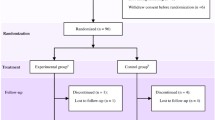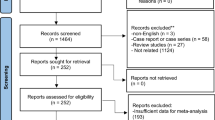Abstract
Study design
Retrospective cohort study.
Objectives
To investigate the effects of 200-unit onabotulinumtoxin A detrusor injections on neurogenic detrusor overactivity (NDO) in patients who have previously been treated with 300-unit injections.
Setting
Tertiary urologic referral center in Switzerland.
Methods
The patient database was screened for patients with NDO as a result of chronic (≥ 12 months) spinal cord injury (SCI), who had been treated with 300- followed by 200-unit onabotulinumtoxin A detrusor injections. Patient characteristics, bladder management data and concurrent bladder medication as well as urodynamic data were collected. The percent changes in the urodynamic parameters from the 300- to the 200-unit treatment phase were calculated to test for non-inferiority of the 200-unit treatment.
Results
The data of 61 individuals with a mean age of 44 ± 15 years (range 18–73 years) and a mean 13.2 ± 9.5 years (range 2–43 years) since SCI were analyzed. The 200-unit treatment was not inferior regarding the urodynamic parameters compared to the 300-unit treatment. Furthermore, the proportion of patients with urinary incontinence was similar for both doses. There was no significant difference in the number of daily bladder evacuations (p = 0.13) or used incontinence pads (p = 0.43) between the two dosage phases. Moreover, there was no significant (p = 0.19) increase in the use of concurrent NDO medication (antimuscarinics or mirabegron) during the 200-unit treatment.
Conclusions
The treatment of NDO with 200 units of onabotulinumtoxin A was not inferior to a 300-unit treatment regarding urodynamic parameters in patients with chronic SCI.

Similar content being viewed by others
Data archiving
The data analyzed during the current study are available from the corresponding author on reasonable request.
References
Hamid R, Averbeck MA, Chiang H, Garcia A, Al Mousa RT, Oh SJ, Patel A, Plata M, Del Popolo G (2018) Epidemiology and pathophysiology of neurogenic bladder after spinal cord injury. World J Urol 36(10):1517–1527
Wyndaele JJ (2016) The management of neurogenic lower urinary tract dysfunction after spinal cord injury. Nat Rev Urol 13(12):705–714
Cetinel B, Onal B, Can G, Talat Z, Erhan B, Gunduz B (2017) Risk factors predicting upper urinary tract deterioration in patients with spinal cord injury: a retrospective study. Neurourol Urodyn 36(3):653–658
Linsenmeyer TA (2013) Use of botulinum toxin in individuals with neurogenic detrusor overactivity: state of the art review. J Spinal Cord Med 36(5):402–419
Tyagi P, Kashyap M, Yoshimura N, Chancellor M, Chermansky CJ (2017) Past, Present and Future of Chemodenervation with Botulinum Toxin in the Treatment of Overactive Bladder. J Urol 197(4):982–990
Tijnagel MJ, Scheepe JR, Blok BF (2017) Real life persistence rate with antimuscarinic treatment in patients with idiopathic or neurogenic overactive bladder: a prospective cohort study with solifenacin. BMC Urol 17(1):30
Ni J, Wang X, Cao N, Si J, Gu B (2018) Is repeat Botulinum Toxin A injection valuable for neurogenic detrusor overactivity—a systematic review and meta-analysis. Neurourol Urodyn 37(2):542–553
Cheng T, Shuang WB, Jia DD, Zhang M, Tong XN, Yang WD, Jia XM, Li S (2016) Efficacy and safety of onabotulinumtoxin A in patients with neurogenic detrusor overactivity: a systematic review and meta-analysis of randomized controlled trials. PLoS ONE 11(7):e0159307
Schurch B, de Seze M, Denys P, Chartier-Kastler E, Haab F, Everaert K, Plante P, Perrouin-Verbe B, Kumar C, Fraczek S, Brin MF (2005) Botulinum toxin type a is a safe and effective treatment for neurogenic urinary incontinence: results of a single treatment, randomized, placebo controlled 6-month study. J Urol 174(1):196–200
Cruz F, Herschorn S, Aliotta P, Brin M, Thompson C, Lam W, Daniell G, Heesakkers J, Haag-Molkenteller C (2011) Efficacy and safety of onabotulinumtoxinA in patients with urinary incontinence due to neurogenic detrusor overactivity: a randomised, double-blind, placebo-controlled trial. Eur Urol 60(4):742–750
Ginsberg D, Gousse A, Keppenne V, Sievert KD, Thompson C, Lam W, Brin MF, Jenkins B, Haag-Molkenteller C (2012) Phase 3 efficacy and tolerability study of onabotulinumtoxin A for urinary incontinence from neurogenic detrusor overactivity. J Urol 187(6):2131–2139
Schurch B, Stohrer M, Kramer G, Schmid DM, Gaul G, Hauri D (2000) Botulinum-A toxin for treating detrusor hyperreflexia in spinal cord injured patients: a new alternative to anticholinergic drugs? Preliminary results. J Urol 164(1):692–697
Chen YC, Kuo HC (2014) The therapeutic effects of repeated detrusor injections between 200 or 300 units of onabotulinumtoxin A in chronic spinal cord injured patients. Neurourol Urodyn 33(1):129–134
Traini C, Vannucchi MG (2019) The botulinum treatment of neurogenic detrusor overactivity: the double-face of the neurotoxin. Toxins 11(11):1–15
Rosier P, Schaefer W, Lose G, Goldman HB, Guralnick M, Eustice S, Dickinson T, Hashim H (2017) International Continence Society Good Urodynamic Practices and Terms 2016: urodynamics, uroflowmetry, cystometry, and pressure-flow study. Neurourol Urodyn 36(5):1243–1260
Wollner J, Kessler TM (2011) Botulinum toxin injections into the detrusor. BJU Int 108(9):1528–1537
Peyronnet B, Castel-Lacanal E, Roumiguie M, Even L, Marque P, Soulie M, Rischmann P, Game X (2017) Intradetrusor injections of onabotulinum toxin A (Botox(R)) 300 U or 200 U versus abobotulinum toxin A (Dysport(R)) 750 U in the management of neurogenic detrusor overactivity: a case control study. Neurourol Urodyn 36(3):734–739
Wyndaele JJ, Van Dromme SA (2002) Muscular weakness as side effect of botulinum toxin injection for neurogenic detrusor overactivity. Spinal Cord 40(11):599–600
Del Popolo G, Filocamo MT, Li Marzi V, Macchiarella A, Cecconi F, Lombardi G, Nicita G (2008) Neurogenic detrusor overactivity treated with English botulinum toxin a: 8-year experience of one single centre. Eur Urol 53(5):1013–1019
Pannek J, Gocking K, Bersch U (2009) Long-term effects of repeated intradetrusor botulinum neurotoxin A injections on detrusor function in patients with neurogenic bladder dysfunction. BJU Int 104(9):1246–1250
Rovner E, Kohan A, Chartier-Kastler E, Junemann KP, Del Popolo G, Herschorn S, Joshi M, Magyar A, Nitti V (2016) Long-term efficacy and safety of onabotulinumtoxin A in patients with neurogenic detrusor overactivity who completed 4 years of treatment. J Urol 196(3):801–808
Funding
We have received no external funding.
Author information
Authors and Affiliations
Contributions
JK: analysis and interpretation of data, writing of the manuscript, approval of final version. JP: project development, interpretation of data, editing of the manuscript, approval of final version. FR: acquisition of data, editing of the manuscript, approval of final version. JW: project development, interpretation of data, editing of the manuscript, approval of final version.
Corresponding author
Ethics declarations
Conflict of interest
The authors declare no conflict of interest.
Ethics statement
This study had been approved by the competent ethics committee (2017–02257) and all applicable institutional and governmental regulations concerning the ethical use of the data were followed. All data were encrypted and kept confidential.
Additional information
Publisher's Note
Springer Nature remains neutral with regard to jurisdictional claims in published maps and institutional affiliations.
Rights and permissions
About this article
Cite this article
Krebs, J., Pannek, J., Rademacher, F. et al. Are 200 units of onabotulinumtoxin A sufficient for the suppression of neurogenic detrusor overactivity in individuals with established 300-unit botulinum toxin treatment? A retrospective cohort study. World J Urol 39, 543–547 (2021). https://doi.org/10.1007/s00345-020-03211-1
Received:
Accepted:
Published:
Issue Date:
DOI: https://doi.org/10.1007/s00345-020-03211-1




